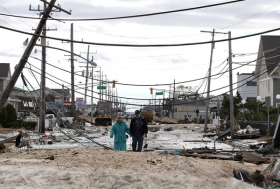On October 29, 2012 the ‘new normal’ crashed into the east coast in the form of a tropical cyclone, forever altering the landscapes and collective psyche of my home state of New Jersey. The now infamous Sandy claimed 80 lives, wiped out entire neighborhoods, and turned reality upside down. Those in the know tell us it will take upwards of a decade to recover from this event, though I am not certain I understand exactly what recovery means.
Some sobering statistics: Sandy’s storm tide ranged from 8 – 14.3 feet in the NY/NJ metro area; 72,000 structures were impacted in New Jersey alone; and an initial estimate of $29.4 billion in physical economic damage is projected to rise as the full economic impact is evaluated, including impacts to New Jersey’s $38 billion leisure, hospitality and recreation industry. Comparatively speaking, Sandy wasn’t even that big of a storm. When you consider that with the additional 1 – 2 feet of sea level rise expected to occur in the region due to climate change, storms less intense than Sandy could generate higher storm tides by mid-century.
One thing I am certain of is that a catastrophe like this makes a compelling illustration of the connections between health and the environment. The impacts of this storm event on individuals and communities are staggering and many of us find ourselves at the beginning of a very steep learning curve. We are learning that the psychological impacts of immediate devastation and long term recovery are deeply felt by the first responders, residents and business owners who grapple with the emotional toll of destroyed houses, displaced families, and economic loss.
Our collective failure to shore up our public infrastructure over the decades is painfully obvious, as failing sewage treatment plants spew untreated effluent into bays and rivers, threatening critical natural resources and public health. Tons of garbage and debris are piling up; Where and how to dispose of it remains a puzzle to be solved, and the impacts to the health and safety of the workers responsible for it of immense concern.
New Jersey boasts the dubious distinction of having the most listed Superfund sites in the country, many in populous urban communities. The Environmental Protection Agency has requested millions of dollars from Congress to stabilize those sites impacted by the storm and to assess and clean up suspected or actual petroleum releases from underground storage tanks. There is also growing concern over relaxed regulation of repair and reconstruction activities in coastal, water front, and tidal wetlands, raising questions about environmental protection and community resiliency in the event of future storms.
If any good can come of this event, it will serve as an opportunity to re-imagine and re-build communities to be resilient, and to engage citizens in a robust recovery and planning effort that challenges old rules and attitudes that will no longer serve us. We are seeing some encouraging signs. For example, a recent poll by Monmouth University reveals that an overwhelming majority of New Jersey residents want the Jersey Shore rebuilt, but in a thoughtful, responsible, and cost-effective manner that takes a regional view and incorporates storm risk assessment to inform decisions on where to allow redevelopment. Also, anecdotal reports from experts and ordinary citizens alike indicate a renewed and expanded appreciation for the protection that natural systems like sand dunes, protected open space, and flood plains provide communities.
In response to these extraordinary circumstances, the Dodge Foundation has partnered with the Community Foundation of New Jersey, contributing $1 million to establish the New Jersey Recovery Fund to support intermediate and long-term recovery efforts. Through this vehicle, we hope to attract investment to support creative and innovative projects to address the wide ranging impacts of this storm. A priority is to support community and nonprofit partners representing a broad range of sectors, including the environment, public health, human services, the arts, and media.
Already, several partners have joined the Fund including: the John S. and James L. Knight Foundation, with a pledge of up to $250,000 to provide matching grants to support community information and storm recovery coverage by local, nonprofit media outlets; the Subaru of American Foundation, providing $250,000 in funds aimed at recovery efforts in south Jersey; and the Dave Matthews Band with a $1 million contribution. The total committed to the Fund to date is more than $3 million and growing.
We can learn from those involved in previous disaster recovery elsewhere. Many of our colleagues in the philanthropic community have reached out to offer advice and assistance on how best to meet the needs of people and the environment in the wake of this storm.
As a state, we will face difficult choices about where we dedicate our resources and what policies will best serve our citizens. As a foundation, we welcome the input and participation from our colleagues as we learn and face these challenges.
Margaret Waldock is the Program Director of the Geraldine R. Dodge Foundation’s Environment program.
Editor’s note: HEFN is hosting a funder briefing on Thursday December 20 at 2-3 p.m. EST with representatives from the philanthropic communities in New Jersey and New York who will share updates on recovery efforts and opportunities. To participate, contact llinville@hefn.org.


